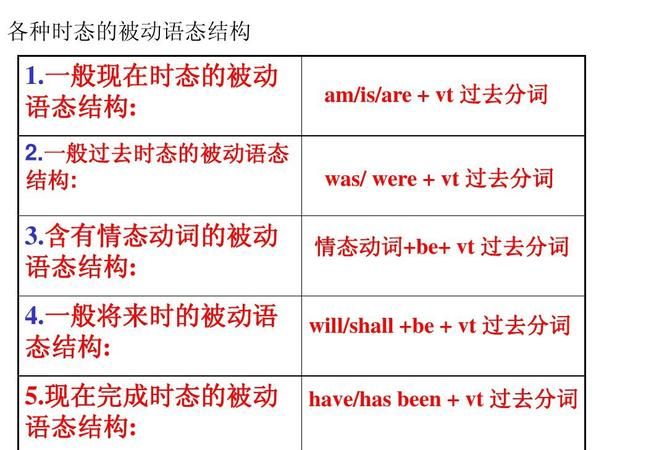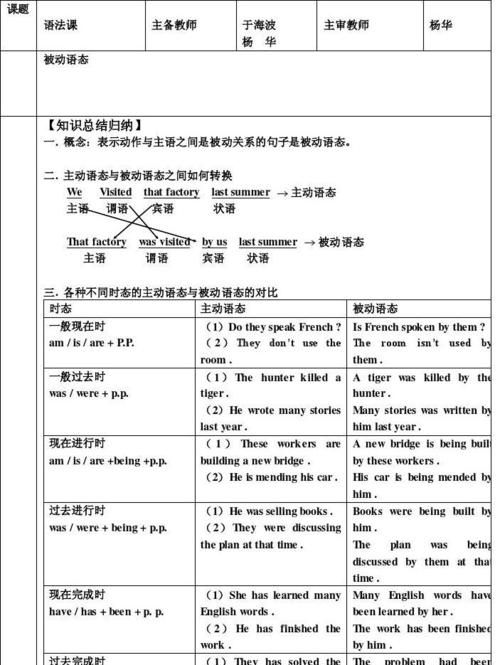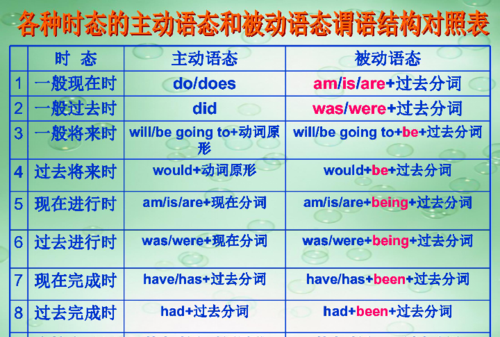本文目录
什么是被动语态和主动语态
一、被动语态的基本用法 当谓语表示一个动作时,主语和它可以有两种不同 关系;主动关系或被动关系。 在表示主动关系时(即主语为动作的执行者时),谓语的形式称为主动语态(the Active Voice)。在表示被动 关系时(即主语为动作的承受者时),谓语要用另一种形 式,称为被动语态(the Passive Voice)。在被动结构的句 子中,动作执行者可以由介词by引起的短语表示。 1.被动语态的构成 被动语态由助动词be加过去分词构成,时态通过 be表现出来。 1)一般现在时 You're wanted on the phone.有人给你打电话。 2)一般过去时 The book was finished last week. 这书是上周写完 的。 3)一般将来时 You'll be allowed to go out tomorrow. 明天让你出去。 4)现在进行时和过去进行时 ① The building is being built. 这幢楼正在建设之中。 ②The bikes were being repaired. 那时正在修自行车。 5)现在完成时和过去完成时 ①This book has been translated into English. 这本 书已被译成英语。 ②The car had been repaired. 这时汽车已修完了。 2.被动语态主要的用法 1)我们不知道或没有必要说明动作的执行者是谁(这时 都不带由by引起的短语)。 The book is written for teachers. 这种书是为教师写的。 2)动作的承受者是谈话的中心(这时可带有by引起的短语)。 The shop is run by a young man.这家商店是由一个年轻人经营的。 3)出于礼貌措辞等方面的考虑不愿说出动作的执行者 是谁。 It is generally considered not advisable to smoke here.一般认为在这儿吸烟是不妥当的。 4)被动结构能使句子得到更好的安排。 Liu Dehua appeared on the stage and was warmly applauded by the audience.刘德华在台上出现,观众给予了热烈的掌声。 5)在汉语中被动结构的句子是很多的,有些带有“被”、 “受”、“由”等词,译成英语时较易想到用被动结构。 ①他被选为我班班长。He was elected monitor of our class. 但在更多情况下却不带这类标记,这种情况值得特别注意。 ②运动会什么时候开? When will the sports meet be held? 二、被动语态的特殊结构 1.带情态动词的被动结构 Water can be turned into vapour.水可转化成蒸汽。 2.带不定式的被动结构 The plan has to be revised. 必须修改计划。 除了单一的及物动词可用于被动结构外,一些相当于及物动词的成语动词也可用于被动结构。常可这样用 的成语动词有: 1)动词+介词 No conclusion has been arrived at so far.到目前为止还没得出结论。 2)动词+副词 The boy was brought up by his aunt. 这个小男孩是由他姑姑带大的。 3)其他成语动词 She was often made fun of. 人们常取笑她。 4)有些动词可以有两个宾语,在用于被动结构时,可以把主动结构中的一个宾语变为主语,另一个宾语仍然 保留在谓语后面。 The manager was asked a number of questions at the press conference. 在记者招待会上,人们问了经理很多问题。 被动语态的用法: 1. 一般现在时的被动语态构成:is / am / are + 及物动词的过去分词 Our classroom is cleaned everyday. I am asked to study hard. Knives are used for cutting things. 2. 一般过去时的被动语态构成:was / were + 及物动词的过去分词 A new shop was built last year. Dinosaur eggs were laid long long ago. 3. 现在完成时的被动语态构成:has / have + been + 及物动词的过去分词 This book has been translated into many languages. Many man-made satellites have been sent up into space by many countries. 4. 一般将来时的被动语态构成:will+ be + 及物动词的过去分词 A new hospital will be built in our city. Many more trees will be planted next year. 5. 含有情态动词的被动语态构成:情态动词+ be + 及物动词的过去分词 Young trees must be watered often. Your mistakes should be corrected right now. The door may be locked inside. Your homework can be handed in tomorrow. 6. 现在进行时的被动语态构成:am / is / are + being + 及物动词的过去分词 Uncle Wang is mending my bike now.→ My bike is being repaired by Tom now. They are planting trees over there. → Trees are being planted over there by them. 7. 不定式的被动语态:to + be + 及物动词的过去分词 There are two books to be read. → There are twenty more trees to be planted. 二、 怎样把主动语态改成被动语态? 把主动语态改为被动语态非常简单,可以遵循以下几个步骤: 1. 先找出谓语动词; 2. 再找出谓语动词后的宾语; 3. 把宾语用作被动语态中的主语; 4. 注意人称、时态和数的变化。 例:1. Bruce writes a letter every week. →A letter is written by Bruce every week. 2. Li Lei mended the broken bike this morning.→The broken bike was mended by Li Lei this morning. 3. He has written two novels so far.→Two novels have been written by him so far. 4. They will plant ten trees tomorrow.→Ten trees will be planted by them tomorrow. 5. Lucy is writing a letter now.→A letter is being written by Lucy now. 6. You must lock the door when you leave.→the door must be locked when you leave. 三、 使用被动语态应注意的几个问题: 1. 不及物动词无被动语态。 What will happen in 100 years. The dinosaurs disappeared about 65 million years ago. 2. 有些动词用主动形式表示被动意义。

不定式的被动语态的构成及其用法
1. 被动语态的构成 由于不及物动词不能带宾语,故无被动语态,只有及物动词或相当于及物动词的动词短语才有被动语态,其基本构成方式是“助动词be+过去分词”。 注意:“be+过去分词”结构不一定都是被动语态,有些动词(如 be,feel,look,seem等)后面的过去分词已转化为形容词,用作表语表示状态。
如: My bike is broken.(我的自行车坏了。) The door is open.(门开了。)
2. 主动语态改被动语态的方法 1)将主动语态改为被动语态应注意以下三个方面:①将主动语态的宾语改为被动语态的主语;②将主动语态的谓语动词改为“be+过去分词”结构;③将主动语态的主语改为介词by之后的宾语,放在谓语动词之后(有时可省略)。 2)含直接宾语和间接宾语的主动语态改为被动语态时有两种情况:①把间接宾语改为被动语态的主语,直接宾语仍保留原位;②把直接宾语改为主动语态的主语,此时,间接宾语前要加介词to或 for。如: He gave the boy an apple.→The boy was given an apple.(或An apple was given to the boy.) Her father bought her a present.→She was bought a present by her father.(或A present was bought for her by her father.) 3)不带to的动词不定式作宾语补足语的主动语态,改为被动语态时不定式前要加to。如: They watched the children sing that morning.→The children were watched to sing that morning. 4)带复合宾语的动词在改为被动语态时,一般把主动语态的宾语改为主语,宾语补足语在被动语态中作主语补足语。如: We call him Xiao Wang.→He is called Xiao Wang. He cut his hair short.→His hair was cut short. They told him to help me.→He was told to help me. 5)短语动词是不可分割的整体,改为被动语态时要保持其完整性,介词或副词不可遗漏。如: We must take good care of the young trees.→The young trees must be taken good care of. 6)含有宾语从句的主动结构变为被动结构时,通常用it作为被动结构的先行主语,从句放在句子后面;也可采用另一种形式。可以这样转换为被动结构的动词有know,say,believe,find,think,report等。如: People believe that he is ill.→It is believed that he is ill.(或:He is believed to be ill.)
3. 被动语态改为主动语态的方法: 被动语态中介词by后的宾语改为主动语态中的主语(或按题意要求确定主语),按照这个主语的人称和数以及原来的时态把谓语动词形式由被动语态改为主动语态。注意在主动语态中有的动词要求不带to的动词不定式作宾语补足语,此时要把被动语态中的to去掉。被动语态的主语用来作主动语态的宾语。如: History is made by the people.?The people make history.
4. 不能用于被动语态的情况 1)某些表示“静态”的及物动词(表示状态而不是动作,而且常常是不可用于进行时态的动词)如have,fit,suit,hold(容纳),cost, suffer,last(持续)等不能用于被动语态。如: They have a nice car.他们有一辆漂亮的汽车。 My shoes don't fit me.我的鞋不合适。 My brain can't hold so much information at one time.我的脑子一下子记不住这么多资料。 How much /What does it cost?这值多少钱? Our holiday lasts 10days.我们的假期有十天。 This food will last(them)(for)3days.这食物足够(他们)(吃)三天。 2)不是所有带介词的动词都能用于被动结构。若是构成成语动词通常有被动态,若不构成成语动词则无被动态。试比较: They arrived at a decision.?A decision was arrived at.他们作出了决定。 They arrived at the station.他们到达车站。(不说:The station was arrived at.) He looked into the question.?The question was looked into.他调查了这个问题。 3)动词leave(离开),enter(进入),join(参加)不可用于被动语态。如: The car left the road and hit a tree.车子离开了道路,撞上了树。 4)某些及物动词可作不及物动词用,特别是后加副词(如well, easily等)时。主动语态有被动含义,这类动词常见的有sell,write, wear,wash,cook,open,close,lock,read,record等。如: His new novel is selling well.他的新小说很畅销。The cloth washes well.这布很耐洗。 This material won't wear.这种材料不耐穿。His play won't act.他的戏剧不会上演。 The window won't shut.这窗关不上。The door won't open.这门打不开。 The door won't lock.这门锁不上。This poem reads well.这首诗读来很好。 5)feel,look,appear,sound,taste,smell等由实意动词演变而来的系动词,后接形容词作表语,不可用于被动语态。如: Tell me if you feel cold.你要是感到冷就告诉我。 You're looking very unhappy?what's the matter?你看来很不高兴???怎么回事儿? The soup tastes wonderful.这汤味道好极了。 Those roses smell beautiful.那些玫瑰好闻极了。 She appears to be friendly.她看上去很友好。 6)宾语是不定式或动词的或-ing形式时,不可用于被动语态。如: Peter hoped to meet her.彼得希望遇见她。 Mr Smith enjoyed seeing his daughter.史密斯先生喜欢看他的女儿。 7)宾语是反身代词或相互代词时,不可用于被动语态。如: She can dress herself.她可以自己穿衣服。 We could hardly see each other in the fog.在雾中我们彼此几乎看不见。 8)宾语是同源宾语时,不可用于被动语态。如: They live a happy life.他们过着幸福的生活。 The girl dreamed a sweet dream .那女孩做了个甜美的梦。 9)宾语带有与主语有照应关系的物主代词时,不可用于被动语态。如: The old man broke his(=the old man's)legs.那老人把自己的腿弄断了。 The girl shook her(=the girl's)head.那女孩摇了摇头。
5. 某些动词的主动形式表被动含义 英语中有很多动词如act,break,catch,cut,clean,drive,draw, let,lock,open,sell,read,write,wash,wear等,当它们被用作不及物动词来描述主语特征时,其主动形式常用来表达被动含义。另外,像 owe,beat,cook,bake,print,build,make等,有时可以用主动形式表达被动含义。如: This kind of radio doesn't sell well.这种收音机不太畅销。 The shop opens at eight o'clock.这个商店八点开门。 The pipe does not draw well.这烟斗不太通畅。 These plays act wonderfully.这些剧演得好。 Kate's book reads like an interesting novel.凯特的这本书读起来像本有趣的小说。 注意:主动表被动强调的是主语的特征,而被动语态则强调外界作用造成的影响。如: The door won't lock.门锁不上。(指门本身有毛病) The door won't be locked.门不会被锁上。(指不会有人来锁门) His novels sell easily.他的小说销路好。(指小说本身内容好) His novels are sold easily.他的小说容易销售。(主要强调外界对小说的需求量大)
6.某些动名词的主动形式表被动含义 1)在need,want,require,deserve和bear等词的后面,动名词用主动形式表示被动含义,其含义相当于动词不定式的被动形式。如: The house needs repairing(to be repaired).这房子需要修理。 My clothes need washing(to be washed).我的衣服需要洗了。 2)形容词worth后面跟动名词的主动形式表示被动含义,但不能跟动词不定式;而worthy后面跟动词不定式的被动形式。如: The picture-book is well worth reading.(=The picture-book is very worthy to be read.)这本画册很值得一读。 Such a man as Mr.Smith is not worth helping.(=Such a man as Mr.Smith is not worthy to be helped.)像史密斯先生那样的人不值得帮助。 This plan is not worth considering.(=This plan is not worthy to be considered.)这个计划不值得考虑。 3)某些动词不定式的主动形式表被动含义 a.当nice,easy,fit,hard,difficult,important,impossible,pleasant, interesting等形容词后跟不定式作状语,而句子的主语又是动词不定式的逻辑宾语时,这时常用不定式的主动形式表达被动含义。如: Japanese is not difficult to learn.日语并不难学。(指日语被学) The water is unfit to drink.这水不适合喝。(指水被喝) The piece of music is pleasant to hear.这首音乐听起来很悦耳。(指音乐被听) This book is easy to read.这本书读起来很容易。(指书被读) b.当动词不定式在名词后面作定语,不定式和名词之间有动宾关系时,不定式的主动形式表示被动含义。如: I have a lot of work to do today.我今天有很多工作要做。(work to do指被做的工作) He has three children to look after.他有三个孩子要照看。(children to look after指孩子被照看) 注意:如果以上句型用动词不定式的被动形式,其含义有所区别。如: I have some clothes to be washed.我有些要洗的衣服。(衣服不是自己洗) c.在there be...句型中,当动词不定式修饰名词作定语时,不定式用主动或被动式,其含义没有什么区别。如: There is a lot of homework to do(to be done).有很多家庭作业要做。 There are some clothes to wash(to be washed).有些衣服要洗。 4)由介词for,on,above,under等构成的短语有时可以表达被动含义。如: His paintings will be on show tomorrow afternoon.=His paintings will be shown tomorrow afternoon.他的油画作品明天下午展出。 5)表示感官意义的连系动词如smell,feel,taste,look,sound等在句子中常表达被动含义。如: How nice the music sounds!这音乐听起来多悦耳! Good medicine tastes bitter.良药苦口。 Our school looks more beautiful than before.我们学校看上去比以前更漂亮了。在主动语态中,使让动词(make,have,let)和感官动词(see, look,watch,notice,listen,hear,feel,find)后必省略to,但在被动语态中必须加上to
例:在教室里我们听见他唱了这首歌
we heard him sing this song in the classroom.
he was heard to sing this song by us in the classroom.
满意采纳

被动语态的基本结构表格
英语中及物动词有两种语态,即主动语态和被动语态。主动语态表示主语是动作的执行者被动语态表示主语是动作的承受者。被动语态由“助动词be+及物动词的过去分词”构成。助动词be有人称、时态和数的变化。
一、被动语态的用法:
1.一般现在时的被动语态构成:is / am / are + 及物动词的过去分词
Our classroom is cleaned everyday.
I am asked to study hard.
Knives are used for cutting things.
2.一般过去时的被动语态构成:was / were + 及物动词的过去分词
A new shop was built last year.
Dinosaur eggs were laid long long ago.
3.现在完成时的被动语态构成:has / have + been + 及物动词的过去分词
This book has been translated into many languages.
Many man-made satellites have been sent up into space by many countries.
4.一般将来时的被动语态构成:will+ be + 及物动词的过去分词
A new hospital will be built in our city.
Many more trees will be planted next year.
5.含有情态动词的被动语态构成:情态动词+ be + 及物动词的过去分词
Young trees must be watered often.
Your mistakes should be corrected right now.
The door may be locked inside.
Your homework can be handed in tomorrow.
6.现在进行时的被动语态构成:am / is / are + being + 及物动词的过去分词
Uncle Wang is mending my bike now.→
My bike is being repaired by Tom now.
They are planting trees over there. →
Trees are being planted over there by them.
7.不定式的被动语态:to + be + 及物动词的过去分词
There are two books to be read. →
There are twenty more trees to be planted.
二、怎样把主动语态改成被动语态?
把主动语态改为被动语态非常简单,可以遵循以下几个步骤:
1.先找出谓语动词;
2.再找出谓语动词后的宾语;
3.把宾语用作被动语态中的主语;
4.注意人称、时态和数的变化。
例:1. Bruce writes a letter every week. →A letter is written by Bruce every week.
2. Li Lei mended the broken bike this morning.→The broken bike was mended by Li Lei this morning.
3.He has written two novels so far.→Two novels have been written by him so far.
4.They will plant ten trees tomorrow.→Ten trees will be planted by them tomorrow.
5.Lucy is writing a letter now.→A letter is being written by Lucy now.
6.You must lock the door when you leave.→the door must be locked when you leave.
三、使用被动语态应注意的几个问题:
1.不及物动词无被动语态。
What will happen in 100 years.
The dinosaurs disappeared about 65 million years ago.
2.有些动词用主动形式表示被动意义。
This pen writes well.
This new book sells well.
3.感官动词或使役动词使用省略to的动词不定式,主动语态中不带to ,但变为被动语态时,须加上to 。
例:make somebody do something→somebody+ be +made to do something
see somebody do something→somebody +be +seen to do something
A girl saw my wallet drop when she passed by.→My wallet was seen to drop by a girl when she passed by.
The boss made the little boy do heavy work.→The little boy was made to do heavy work by the boss.
4.如果是接双宾语的动词改为被动语态时,直接宾语(物)作主语,那么动词后要用介词,这个介词是由与其搭配的动词决定。
He gave me a book.→A book was given to me by him.
He showed me a ticket.→A ticket was shown to me by him.
My father bought me a new bike. →A new bike was bought for me by my father.
5.一些动词短语用于被动语态时,动词短语应当看作一个整体,而不能丢掉其中的介词或副词。
We can’t laugh him. →He can’t be laugh by us.
He listens to the radio every day. →The radio is listened to by him every day.
The nurse is taking care of the sick man. →The sick man is being taken care of by the nurse.
这些都是了还有一些是特殊的 那就只有自己去积累

英语被动语态用法总结高中
被动语态由“助动词be+及物动词的过去分词”构成。人称、数和时态的变化是通过be的变化表现出来的。现以teach为例说明被动语态在各种时态中的构成。
一般现在时:am/is/are+taught
一般过去时:was/were+taught
一般将来时:will/shall be+taught
现在进行时:am/is/are being+taught
过去进行时:have/has been+taught
现在完成时:have/has been+taught
歌诀是:被动语态be字变,过去分词跟后面。
三、被动语态的用法
(1)不知道或没有必要说明动作的执行者是谁。
例如:
Some new computers were stolen last night.
一些新电脑在昨晚被盗了。(不知道电脑是谁偷的)
This book was published in 1981.这本书出版于1981年。
(2)强调动作的承受者,而不强调动作的执行者。
例如:the window was broken by Mike.窗户是迈克打破的。
This book was written by him.这本书是他写的。
Eight hours per day for sleep must be guaranteed.每天8小时睡眠必须得到保证。
歌诀:谁做的动作不知道,说出谁做的没有必要;
动作承受者需强调,被动语态运用到。
四、主动语态变被动语态的方法
(1)把主动语态的宾语变为被动语态的主语。
(2)把谓语变成被动结构(be+过去分词)
(根据被动语态句子里的主语的人称和数,以及原来主动语态句子中动词的时态来决定be的形式)。
(3)把主动语态中的主语放在介词by之后作宾语,将主格改为宾格。例如:
All the people laughed at him.
He was laughed at by all people.
They make the bikes in the factory.
The bikes are madeby themin the factory

以上就是关于被动语态的构成和用法,什么是被动语态和主动语态的全部内容,以及被动语态的构成和用法 的相关内容,希望能够帮到您。
